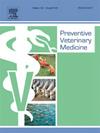Tissue cyst-based quantitative risk assessment of human toxoplasmosis from consuming pork in Denmark: A farm-to-fork approach
IF 2.2
2区 农林科学
Q1 VETERINARY SCIENCES
引用次数: 0
Abstract
Toxoplasma gondii is an important foodborne pathogen. The aim of this study was to develop a tissue cyst-based quantitative risk assessment model to estimate the probability of human infection with T. gondii from consuming pork in Denmark. A 'farm-to-fork' model was developed to trace the path of T. gondii infection, beginning with the true seroprevalence in pigs and proceeding to the estimation of tissue cysts in portions of pork. The model then accounted for the number of infectious portions post preparation and prior to consumption. Thereafter, the model estimated the probability of human infection from consumption of infectious portions using a dose-response model. The model predicted the prevalence of T. gondii infections in humans, with the assumption that infections did not equate clinical illness. The average estimated prevalence at the age of 75 years ranged from 58.8% to 88.8%, depending on specific model scenarios. Furthermore, the predicted prevalence was higher for portions originating from conventionally raised pigs compared to those from organic pigs. This was due to the significantly higher proportion of consumption of conventional pork compared to organic pork, and despite the per-portion risk being higher for organic pork. The model identified that undercooked pork, dry-cured sausages, and smoked products pose a risk of infection. The probabilities of human infection per portion consumed were estimated at 7.3 × 10⁻⁴, 4.7 × 10⁻⁴, and 1.2 × 10⁻5, respectively. However, the actual risk posed by dry-cured sausages remains uncertain due to limited data on the effectiveness of salting applied in dry-cured sausage processing. It was epidemiologically challenging to build the model due to the lack of comprehensive data on salting processes and the complexity of accurately reflecting industry standards. The age-specific prevalence offers limited value for public health decision-making; however, attribution of risk to specific pork products and in comparing organic and conventional pork provides more actionable insights for the future.
丹麦食用猪肉引起的人类弓形虫病基于组织囊肿的定量风险评估:从农场到餐桌的方法
刚地弓形虫是一种重要的食源性病原体。本研究的目的是建立一个基于组织囊肿的定量风险评估模型,以估计丹麦人因食用猪肉而感染弓形虫的概率。开发了一个“从农场到餐桌”的模型来追踪弓形虫感染的路径,从猪的真实血清患病率开始,然后估计猪肉部分组织囊肿。然后,该模型计算了制备后和食用前感染部分的数量。此后,该模型使用剂量-反应模型估计了人类因食用传染性部分而感染的概率。该模型预测了弓形虫感染在人类中的流行程度,假设感染并不等同于临床疾病。根据具体的模型情景,75岁人群的平均估计患病率在58.8%至88.8%之间。此外,与来自有机猪的部分相比,来自传统饲养猪的部分的预测患病率更高。这是由于与有机猪肉相比,传统猪肉的消费比例要高得多,尽管有机猪肉的每份风险更高。该模型发现,未煮熟的猪肉、干腌香肠和烟熏产品有感染的风险。每一份食物的人类感染概率分别估计为7.3 × 10⁻⁴,4.7 × 10⁻⁴和1.2 × 10⁻5。然而,由于在干腌香肠加工中应用盐的有效性的数据有限,干腌香肠的实际风险仍然不确定。由于缺乏关于腌制过程的全面数据以及准确反映行业标准的复杂性,从流行病学角度来看,建立模型具有挑战性。特定年龄患病率对公共卫生决策的价值有限;然而,将风险归因于特定的猪肉产品,并将有机猪肉与传统猪肉进行比较,为未来提供了更可行的见解。
本文章由计算机程序翻译,如有差异,请以英文原文为准。
求助全文
约1分钟内获得全文
求助全文
来源期刊

Preventive veterinary medicine
农林科学-兽医学
CiteScore
5.60
自引率
7.70%
发文量
184
审稿时长
3 months
期刊介绍:
Preventive Veterinary Medicine is one of the leading international resources for scientific reports on animal health programs and preventive veterinary medicine. The journal follows the guidelines for standardizing and strengthening the reporting of biomedical research which are available from the CONSORT, MOOSE, PRISMA, REFLECT, STARD, and STROBE statements. The journal focuses on:
Epidemiology of health events relevant to domestic and wild animals;
Economic impacts of epidemic and endemic animal and zoonotic diseases;
Latest methods and approaches in veterinary epidemiology;
Disease and infection control or eradication measures;
The "One Health" concept and the relationships between veterinary medicine, human health, animal-production systems, and the environment;
Development of new techniques in surveillance systems and diagnosis;
Evaluation and control of diseases in animal populations.
 求助内容:
求助内容: 应助结果提醒方式:
应助结果提醒方式:


